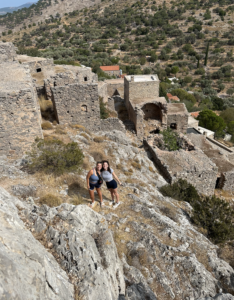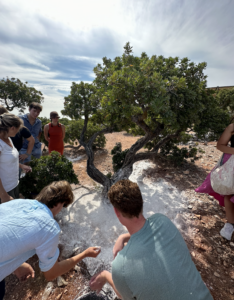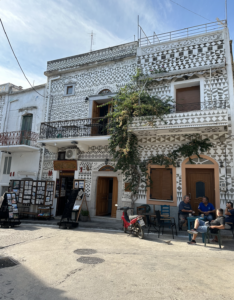School sponsored trip to a Greek island? Count me in. As part of its experiential learning initiative, CYA offers many opportunities for on-site learning. Each semester, students are required to attend two field studies. This fall, we are going to Crete and the Peloponnese. In addition to these thematic trips, CYA offers several optional trips. The first optional trip was to an island off the coast of Turkey called Χίος (Chios). Less than an hour after leaving Athens, we traded the Acropolis for the crystal blue waters of the Aegean Sea. Being one of the Mediterranean’s biggest and historically rich islands, we had a lot to accomplish in the next three days. I could write a book on this trip alone, so I’ll give you a couple of highlights and takeaways.

Our first stop was up to the abandoned village of Anavatos (Ανάβατος). Established in the Byzantine era, this medieval village was abandoned after the Massacre of Chios in 1822 and the earthquake of 1881. While the village was desolate, much was still to learn about the city. We went up and down the hills and in and out of houses where possible. Even after so much time and destruction, the foundations remained intact; it was pretty impressive!
The following day, we learned more about the identity and history of the island. From a foreigner’s perspective, Chios takes its communal identity very seriously, as it is deeply rooted in the island’s history. With this in mind, we went to a Mastic farm and museum unique to Chios. Mastic (Μαστίχα) is a type of resin that comes from Mastic trees in a crystal-like formation. In Chios, and Greece, more broadly, Mastic is used to make high-quality products like gum, pastries, bread, beauty products, and a liqueur called Mastika. If you ever come across a product with Mastic in it, you should give it a try! We even had the chance to harvest some Mastic from the trees. Overall, it’s a tedious process and takes a lot of dedication and hard work to keep up with it for the season.

At the end of the day, we made it to a volcanic beach called Mavra Volia (Παραλία Μαύρα Βόλια). This isolated beach was full of small black pebbles that resulted from a volcanic eruption sometime during the prehistoric era. Without the proper shoes, it was quite tricky to walk on the rocks. It was so worth it! Over the weekend, we went to three beaches, all beautiful in their own ways, but Mavra Volia was by far the best one.

Sure, no serious formal lectures were going on, but I still learned a lot about Chios as an island and also a community. There is a lot of deep pride and enthusiasm that speaks for itself. I saw this on the beaches, on the Mastic farm and just by walking around different villages. I also have a couple of friends who come from this island (I know, it’s such a small world); even at home, they constantly talk about their connections to Chios, even when they’re so far away. It was an overall incredible experience, something I couldn’t have imagined doing without this program. Shoutout to Angela, our incredible tour guide, who also comes from Chios!
Thank you for reading along today, and be sure to anticipate my next blog post about our field study in Crete!




One Reply to “The Island of Χίος”